|
Big Wells Are Good, Right?
DR. JOE HENGGELER
PORTAGEVILLE, MO.
Irrigation in the Missouri Bootheel is unique. Whenever someone involved in irrigation visits me, I explain to them that the Bootheel area of Missouri has three distinctive elements that shape the nature of its irrigation, making it unique from any other place in the irrigation world. The first is that it lies within three hours one of the finest pump manufacturers in America, American-Marsh Pumps, in Collierville, TN. A farmer’s pump that goes down in the morning can be replaced, and up and running by quitting time.
The second factor stems from the fact that rice has been grown in the Southeast Missouri region (SEMO) for many years. This has led to the availability of LASER-controlled land-grading equipment from both privately- and commercially owned sources. This fact, plus many years of dollar-a-gallon diesel, has resulted in a vast majority of surface-irrigated fields in the SEMO region being LASER-leveled; survey data indicate that today around 70 percent of the furrow fields are so treated. Even pivot-irrigated fields are often laser-leveled (33 percent), as are dryland fields (7 percent). Therefore, even though the region averages close to 50 inches of rainfall a year, the overall excellent surface drainage resulting from precision land leveling mitigates high-rainfall related problems.
The last factor has two parts: the primary one is the wonderful underground water resource we have, the Mississippi Alluvial Aquifer. Not only is water abundant, it is cheap – both in pumping it and in development of it (normal depth of wells is only about 100 feet). The second part of this factor is Poly-pipe. Poly-pipe generally comes in 1320-foot rolls, just the right length to water a square 40 acres. Two people layout Poly-pipe at the head of the field; one is driving the tractor that is spooling out the pipe into a shallow furrow that is being gouged ahead of the spool. The other person follows behind scooping a shovelful of dirt on top of the flattened pipe every 25 feet or so, in order that the wind won’t twist it prior to it being filled with water for the first time, after which, even when flow is shut off, weights it down to keep twisting from occurring. If it is calm and the plans are to immediately turn on the water, the shovel hand could be dispensed with.
As the water is turned, on a man with a plastic spiking mace walks along and punches holes (Fig. 1), usually, every-other water furrow. So in a couple of man hours a forty acre field is ready to irrigate. Each irrigation application again requires minimal labor – one just turns on the pump. If two forty-acre fields lie side by side, a surge flow valve can be used, thus irrigating 80 acres at the throw of a switch.
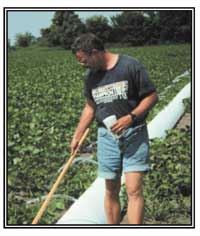
Fig. 1. Watering with Poly-pipe.
What in effect has occurred when Poly-pipe is coupled with SEMO’s high capacity wells is that furrow irrigation, thought to be the bottom-feeder of bottom-feeders in terms of labor (c.f., Fig. 2), is now one of the least labor intensive methods of irrigation!
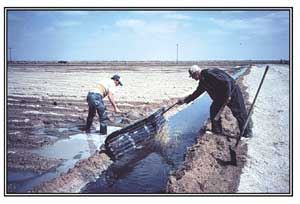
Fig. 2. Another, more laborious, method of furrow irrigation.
The key to pulling off Poly-pipe’s remarkable minimization of labor requirements is that there needs to be enough pumped water, such that punched outlets the entire length of pipe all themselves have adequate flow to run down each furrow. For 38-inch spacing and watering every other furrow, there will be approximately 200 orifices watered at once. Depending on soil type, slope, and field length the flow down each furrow should be at least 10 GPM. This translates 2000 GPM being required. When farmers do not have enough water there are tricks they can use, like running two lines of Poly-pipe which doubles the furrow flow.
If there is not enough flow and the irrigator has to begin closing some gates and opening up others during the day, labor requirements burgeons and the method is no longer low-labor. The alternative is to go back to moving gated pipe, very hard and tedious work. There is a joke that center pivot irrigation was the downfall of Nebraska’s football program, as the supply of Cornhusker farm boys, beefed up from toting 30 and 40 sticks of heavy 10-inch aluminum pipe all day, began to diminish.
The Bootheel water supply.
The average flow rate for the approximately 12,000 wells in the ten Bootheel and surrounding delta counties is around 1350 to 1400 GPM. However, approximately, 3,500 of those wells supply water for center pivots (whose average size in the Bootheel is 105 acres), so these wells, probably averaging 900 GPM, are not running full bore. Figure 3 shows the percentage of these 12,000 wells by pumping capacity. The data comes from 2012 USDA/NASS report on irrigation. The vast majority of the Bootheel wells are in the 1000-1499 GPM category. Only eleven percent of the wells are over 2000 GPM. The average for this group is 2,466 GPM. In the Bootheel there are a few wells that pump 3000 – and even 4000 – GPM, but they are fairly rare.
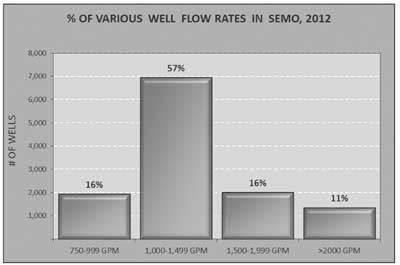
Fig. 3. The percentage of wells in the southeast Missouri region by pumping capacity.
Paying the Piper
Wells with flow rates of 1000-, 2000-, 3000-, and 4000-GPM would all experience increasingly more drawdown as flow rate increases, but not proportionally so. For example, the drawdown of the 2000 GPM rate would not be twice that of the 1000 GPM rate (it’s actually more than twice). This is because specific capacity (GPM/foot of drawdown) decreases with increased flow rates. Thus, the pumping water level (PWL), which drives the energy cost, is impacted two ways by increased the pumping rate. As an example, if a well being pumped at a 1000 GPM has a drawdown of 15 feet, then increasing the flow to 2000 GPM (another 1000) would at least have the same additional 15 feet of drawdown. However, the law of diminishing returns (actually Darcy’s law) comes into play, and that new 1000 GPM, instead of just drawing down 15 feet as the first 1000 did, might instead require a drawdown of 20 feet. Revving up to 3000 GPM, this next 1000 GPM step causes increased levels of drawdown due to decreased specific capacity, so the added drawdown won’t be the 15 or 20 feet as for the first and second 1000 GPM, but instead might require 25 feet. Let’s say the original static water level was at 10 feet, then a 1000 GPM flow would have a PWL of 25 feet, a 2000 GPM flow a PWL of 45 feet, and the 3000 GPM flow would have a PWL of 60 feet. The specific capacity would be 67, 57, and 50 GPM/foot, respectively, for those flow rates.
Also, tied into the mix is that friction loss in the column pipe increases with flow. The net result is that the farmer with the 3000 GPM is probably paying almost 3 times more for his water than his neighbor pumping 1000 GPM. Increasing the column pipe diameter will reduce the friction loss costs, but does nothing to mitigate the cost associated with increased PWLs. Figure 4 shows the minimum cost for an acre-inch of water for 1000, 2000, 3000, and 4000 GPM flows for both 10- and 12-inch column pipe based on diesel at $3.50 per gallon. These are the lowest possible attainable costs based on the laws of physics and mechanics. If the pumping plant is less than 100 percent efficient (only 15 percent of units nationwide reach this level), the costs would be more than shown in figure 4.
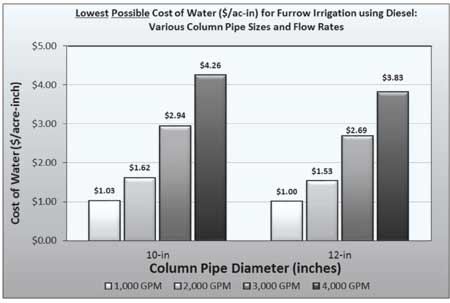
Fig. 4. The lowest possible cost for an acre inch of water for
1000, 2000, 3000, and 4000 GPM for 10- and 12-inch column pipe.
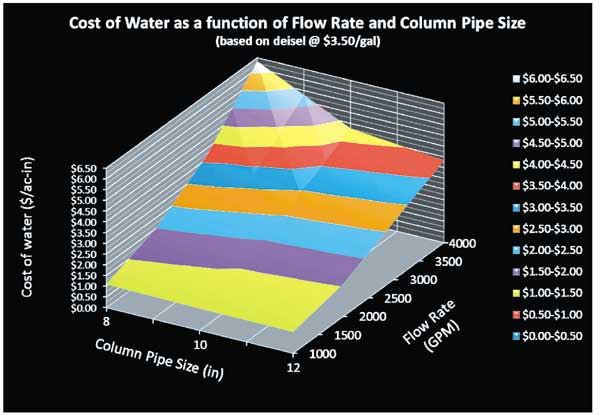
Fig. 5. A 3-D representation of the lowest possible
cost for an acre inch of water for 1000, 2000, 3000,
and 4000 GPM for 8-, 10-, and 12-inch column pipe.
The recent an analysis of approximately 150 pumping plant evaluations on furrow-irrigated fields conducted in the SEMO area showed that, as surprising as it sounds, pumping plant efficiency has virtually no correlation to the cost of water. On the other hand, PWL was highly correlated to pumping costs (R2 = 0.71). Therefore, high PWLs caused be over zealous pumping and/or poorly constructed wells having low specific capacities, should be avoided.
It should be noted that it is not the increased pumping water levels themselves adding to the cost for pumping water on a per acre-inch basis, since this value factors out. For example doubling the flow rate, say from a level of 1000 GPM to 2000 GPM, also doubles the acre-inches pumped. The added costs generated from increased flow rates stems primarily from increased levels of PWL and friction loss. However, other charges not considered here, would be higher capital costs and, if electric, possibly higher stand-by charges.
On the Surface Problems, Too
The differences in cost stemming from pump flow rate amounts doesn’t end once the water has reached the surface. For one thing, if 12-inch pipe size is needed, costs step up quickly, partially due to less of that size being manufactured, but also due to transportation costs – not too many linear feet of 12-inch pipe can be hauled on an 18-wheeler. The friction loss in an above ground buried pipe system for 4000 GPM could be as high as the head required to lift the water to the surface.
The advantage that Poly-pipe provides our farmers is important, and we need adequate amounts of water in order to carry it off. However, using pumps that produce over 3000 GPM might can lead to extra cost. It might be more economical to have two smaller sized wells than one huge well. Bigger may not be better. The one exception to this would be if the region had lined surface ditches, where friction loss doesn’t become a factor. In this case, bigger would be better. ∆
DR. JOE HENGGELER: Extension Irrigation Specialist, University of Missouri
|
|